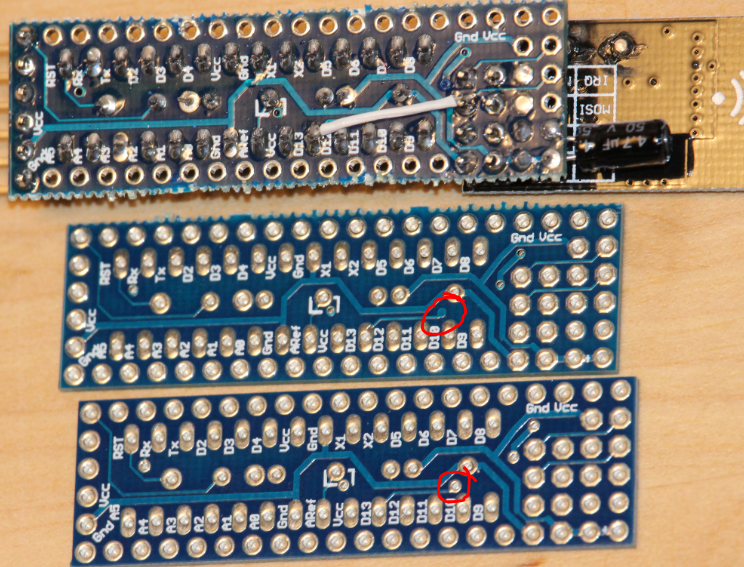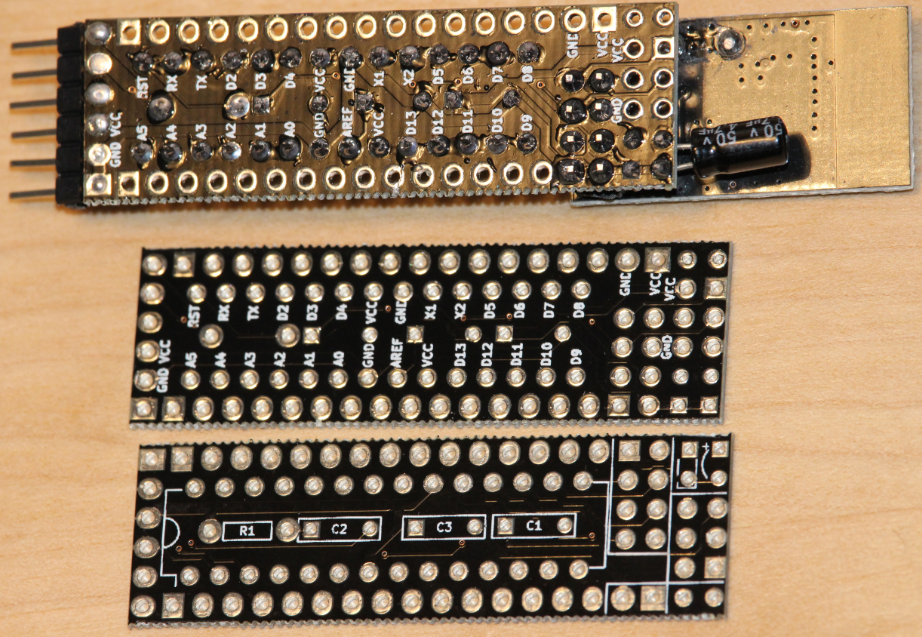My Slim 2AA Battery Node
-
Like the board and ordered it. Can you also post exactly the capacitor types? Keep up the good work.
@betonishard There aren't any exact values or types, but good start would be
Near the radio supply: One radial electrolytic >=4.7uF >=10V capacitor together with one ceramic (range 1pF - 1uF. I use different.).
The rest (C1, C2, C3): 0.1uF ceramic, where the value probably matters most for C2 (the Reset capacitor)
-
@betonishard There aren't any exact values or types, but good start would be
Near the radio supply: One radial electrolytic >=4.7uF >=10V capacitor together with one ceramic (range 1pF - 1uF. I use different.).
The rest (C1, C2, C3): 0.1uF ceramic, where the value probably matters most for C2 (the Reset capacitor)
@m26872
Thanks... Maybe it is answered, but I didn't quite catch it. 3v will be fed to the radio, but isn't the 3.3 important instead of 3v? I don't see any stepup. Is your range acceptible?Thanks...
-
I have had a node sending messages as low as 1.65V :-)
-
@mfalkvidd @GertSanders Thanks for your answers!! How about the range, I know it is depending on the quality of Chinese products, however can you give an estimate regarding your setups?
-
Short answer: Expect about the same range as a regular wifi card.
Long answer: Look at these informative and quite entertaining videos:
Ultimate nRF24L01 range comparison
nRF24L01 range test (arduino)
nRF24L01 range test part 2 (arduino) -
I was about to order the 1.4v of your board before that i wanted to ask you a basic question, do i need to use any step up regulator to connect any 5v sensors? Have you connected any 5v sensors, if yes could you please post some pictures?
Thanks again for the great work.
-
You will indeed need to use a step-up regulator to use 5V sensors, as his board is 2AA battery based (gives maximum 3.2V on fresh batteries). For quite some sensors, you will find 3V3 versions, which can work at even lower voltages. look for sensors which work down to 1.8V-1.9V
Using 5V sensors in a battery based node is not efficient. -
You will indeed need to use a step-up regulator to use 5V sensors, as his board is 2AA battery based (gives maximum 3.2V on fresh batteries). For quite some sensors, you will find 3V3 versions, which can work at even lower voltages. look for sensors which work down to 1.8V-1.9V
Using 5V sensors in a battery based node is not efficient.@GertSanders Thank you so much. Is there a recommended list of low voltage sensors? The Mysensor store only has 5v sensors i believe. I will other search other forum post as well. If anyone know from top of their head please list it.
Temperature sensor - ?
Humidity sensor - ?
Luminosity sensor - ?
PIR - ?
Infrared sensor -?
Soil Moisture sesnor -? -
I also was about to order the 1.4 board. But are there any list of components that I need to complete the board?
-
I also was about to order the 1.4 board. But are there any list of components that I need to complete the board?
@Cliff-Karlsson Sorry for late reply. I've not yet a BOM. I'll try o fix it later.
-
NEWS:
- A "final" version 2.0 redesigned i KiCad (very similar layout), panelized, ordered and tested OK.
- A faulty via was introduced during panelization of v1.2, so the panelized v1.2 (blue board) needs a small fix to work.
More info ASAP.
Edit 4/11: There seems to be no issues with v1.4 (red board) as I thought first. Luckily since it's now been shared a few times.
-
NEWS:
- A "final" version 2.0 redesigned i KiCad (very similar layout), panelized, ordered and tested OK.
- A faulty via was introduced during panelization of v1.2, so the panelized v1.2 (blue board) needs a small fix to work.
More info ASAP.
Edit 4/11: There seems to be no issues with v1.4 (red board) as I thought first. Luckily since it's now been shared a few times.
-
@AWI It should be easy the see the via with a missing hole. A connecting wire between Arduino D13 and nRF SCK is needed.

-
I've now tested v1.4 (red board) and it's working good in my MyS-net.
I can see that it has been shared 12 times at DirtyPCB, but don't know how I can see any money as suggested? As soon as I see any they'll be sent to MySensors.org.
Edit: Seems that I had a missing confirmation of my Paypal account. I'll try to solve this...
-
I decided to start learning KiCad instead of Eagle and that a tidy redesign of the Slim Node board would be a good start. Now when the red v1.4 board turned out to be quite ok (apart from the references R1,R2, R3, etc, as you can see above), I guess one can choose v1.4 or v2.0 by colour or by documentation. The v1.4 wasn't very well documented since I never really learned Eagle very good. I think that's improved now with v2.0. I've tested all the regular attributes (AVR ISP pins excluded) and it's OK.
This is my "final" version since I have a full stock of these boards for a while. If someone else want to pick up the design you're welcome.Here's all the KiCad files: MySlimNode2.0-kicad-design-doc.zip
Gerbers only in the panelized version folder.Here's a BOM (for v2.0): v2_BOM.txt
Purchase link to boardhouse (DirtyPCB). $1/order goes to MySensors.org like before.
This time it's black:

-
@m26872 Maybe you can add your info to this message (it's pinned):
http://forum.mysensors.org/topic/595/pcb-boards-for-mysensors

